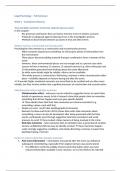Summary
Summary Elective 3.3 Legal Psychology
- Course
- Institution
This is a full summary of all the literature of the Elective Legal Psychology, which is given in year 3 of the Psychology Master at EUR. If the literature changes, it might contain some abundant information. It is 93 pages, so very extensive!
[Show more]



